
Audio-Technica AT5040 Voiceover Mic Review
Wednesday, July 10th, 2013 | by Randy Coppinger
Most of what can be said about the Audio-Technica AT5040 depends on the voice we are hearing and the other microphone with which we were comparing it. Listening to several voices and against several microphones was far more informative than the usual head-to-head “shootout” with a single sound source. I have been claiming for years that there is no single “best” microphone for every situation; this broad sampling is further evidence of that claim.
Compared to most of the other mikes, the AT5040 had a slight advantage in the bass. Most of the mikes on all voices seemed to bring out a little more of the mids than the AT5040, but the mic never sounded lacking either. There were moments of presence, air, and even top end shimmer on the AT5040, though never hyped or exaggerated.
I don’t think the AT5040 can be characterized as entirely “true,” but the embellishments it brought were sweet and subtle, never heavy handed. It always managed to sound coherent and clear, while some of the other mikes were smeary or thick by comparison. Consistent clarity is a wonderful quality for a microphone.
It seemed like the AT5040 flattered the low end of male voices, but only slightly. It was a tad more round and rich sounding than the Neumann U87Ai or Microtech-Gefell UMT 70, but not as warm as the Lawson L47MP. The AT5040’s low end sounded tight and true with female voices. The U87Ai seemed a bit bigger, and fuller on women to the point of sounding unnatural. The AT5040 was more realistic in the first octaves.
On some of the quieter performances, I noticed spikes around 18 kHz on an RTA. I suspect this could be the resonant frequency of the elements, or an artifact of the summing matrix used to combine the outputs of the four elements, though I could be wrong. [Audio-Technica’s engineering department states that none of their AT5040 frequency analyses, nor time-domain analyses show any spikes at 18kHz. –Ed.]
I was concerned that the mic had no pad, nor low rolloff. There were times when the mic popped on plosives, but it didn’t seem any more prone to pops than other mikes. I suppose the lack of pad might be a problem in some situations, but we had some crazy loud yelling performances and the AT5040 never clipped.
AT5040 vs U87Ai
The AT5040 sounded clearer. The  Neumann U 87 Ai seemed to have a resonant and lingering bass, whereas the AT5040 was tighter and truer. The U87 seemed to have a bit more mid-range, which was more present for some voices, but more nasal on others. The AT5040 sounded more coherent in the high end compared to the U87, which sounded a little smeared. I believe this helped the u87 seem less sibilant in some cases whereas the AT5040 delivered every piercing sound faithfully.
Neumann U 87 Ai seemed to have a resonant and lingering bass, whereas the AT5040 was tighter and truer. The U87 seemed to have a bit more mid-range, which was more present for some voices, but more nasal on others. The AT5040 sounded more coherent in the high end compared to the U87, which sounded a little smeared. I believe this helped the u87 seem less sibilant in some cases whereas the AT5040 delivered every piercing sound faithfully.
When room reflections got in the mic, the U87 tended to let us hear the upper bass and mid-range. The AT5040 room reflections seemed lower — a deep bass. Depending on the voice and performance, the room reflections sounded better in one mic or the other, but not consistently favorable in either. Overall, the AT5040 sounded direct and true, with a little embellishment in the very lows and very highs. The U87 seemed thicker, revealing the upper bass and mid-range, with some high-end hype.
AT5040 vs L47MP Mk II
The  Lawson Inc L47MP MKII had a creamy, sculpted quality. It was bigger and rounder than the AT5040, which sounded dry and flat by comparison. The L47 had authority; it got my attention. The AT5040 sounded naked, exposed, without the voice flattery. Bass tones lingered from the L47, whereas the AT5040 was tight and true on bottom. The L47 was a bit glassy on top, but the AT5040 sounded direct, dry. Neither mic seemed airy, though. The L47 was thicker, though the AT5040 did not lack weight. The AT5040 had a bit more edge, but not shrill compared to the L47. The L47 tended to allow less sibilance than the AT5040. The AT5040 seemed more intimate with quiet reads, and allowed a bit less off-axis room sound.
Lawson Inc L47MP MKII had a creamy, sculpted quality. It was bigger and rounder than the AT5040, which sounded dry and flat by comparison. The L47 had authority; it got my attention. The AT5040 sounded naked, exposed, without the voice flattery. Bass tones lingered from the L47, whereas the AT5040 was tight and true on bottom. The L47 was a bit glassy on top, but the AT5040 sounded direct, dry. Neither mic seemed airy, though. The L47 was thicker, though the AT5040 did not lack weight. The AT5040 had a bit more edge, but not shrill compared to the L47. The L47 tended to allow less sibilance than the AT5040. The AT5040 seemed more intimate with quiet reads, and allowed a bit less off-axis room sound.
AT5040 vs UMT70S
 |
Yuri Lowenthal (shouting) Yuri Lowenthal Tara Platt (shouting) |
 |
Yuri Lowenthal (shouting) Yuri Lowenthal Tara Platt (shouting) |
The  Microtech Gefell UMT 70 S seems more present, to a point of sounding aggressive, though not shrill. The AT5040 seems full and true in the low end, while the UMT70S seems thin by comparison. The UMT70S had better clarity and a diction advantage. Not that the AT5040 sounded veiled or thick, just that the UMT70S seemed punched up when listening side by side. The AT5040 sounded more open on top, bringing some voices closer. The extended high end also enabled the AT5040 to allow more sibilance than the UMT70S. But neither sounded harsh. As we might expect from the overall profiles of these mikes, the room tone of the AT5040 was deeper than the UMT70S.
Microtech Gefell UMT 70 S seems more present, to a point of sounding aggressive, though not shrill. The AT5040 seems full and true in the low end, while the UMT70S seems thin by comparison. The UMT70S had better clarity and a diction advantage. Not that the AT5040 sounded veiled or thick, just that the UMT70S seemed punched up when listening side by side. The AT5040 sounded more open on top, bringing some voices closer. The extended high end also enabled the AT5040 to allow more sibilance than the UMT70S. But neither sounded harsh. As we might expect from the overall profiles of these mikes, the room tone of the AT5040 was deeper than the UMT70S.
AT5040 vs AT4050
 |
Tara Platt (character 1) Tara Platt (character 2) Tara Platt |
 |
Tara Platt (character 1) Tara Platt (character 2) Tara Platt |
The most noticeable difference is the high end, where the  Audio-Technica AT4050 was brighter and the AT5040 was duller. The AT4050 sounded bright on most voices — too bright. On some voices the AT4050 was sibilant, even harsh. By contrast, the AT5040 sounded thick though this was almost always desirable compared to the hype of the AT4050. Otherwise these mikes were quite similar. The lowest of low end on the AT5040 seemed a tad bit more round, but this was a subtle difference.
Audio-Technica AT4050 was brighter and the AT5040 was duller. The AT4050 sounded bright on most voices — too bright. On some voices the AT4050 was sibilant, even harsh. By contrast, the AT5040 sounded thick though this was almost always desirable compared to the hype of the AT4050. Otherwise these mikes were quite similar. The lowest of low end on the AT5040 seemed a tad bit more round, but this was a subtle difference.
Session Details
| Location: | Igloo Music Studios, Burbank, CA |
| Recording Engineer: | Ethan Friedericks |
| Microphone Positioner: | Randy Coppinger |
| Format: | 32 bit floating point, 96 kHz sample rate |
| Acquisition Chain: | Grace m501 → Apogee Rosetta 200 |
All recordings were made with two microphones recording the same performance at the same time. Every effort was made to position the microphones similarly in front of a performer and use identical recording paths. There should be little or no difference in performance nor acquisition chain to distract the listener from the qualities of the microphones under comparison.
Conclusion
The AT5040 impressed, and seemed like a mic that will be considered a classic. With so many microphone choices, what separated this one from most others was the unique design and the subtle, tasty sonic enrichment on voice. For the price it had better be a very good mic, and it lived up to that expectation for me.
To be honest, I anticipated the combination of four elements might create strange artifacts. But in actual use I found the mic more accurate and coherent than the other mikes under comparison. The AT5040 achieved its stated goal of being a voice microphone, with flying colors. Anyone who records voice would be well served to own this mic.
Voice Actors
Find out more about the five wonderful voice actors who participated in this evaluation:
Corey Burton
Yuri Lowenthal
Julie Nathanson
Tara Platt
Stephanie Sheh
Pirates and Announcers
To hear more of Corey Burton’s voices, through a lot more microphones, please see:
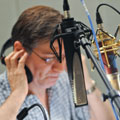 |
|
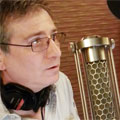 |
|
|
If you ever record voice, even your own voice, you can probably improve your results immediately with tips #1, #5, and #6 from this piece on 10 Voice Recording Essentials. |
Tags: Corey Burton, Ethan Friedericks, Julie Nathanson, Stephanie Sheh, Tara Platt, Yuri Lowenthal
Posted in Microphones, Reviews, Shootouts, voiceover | 11 Comments »
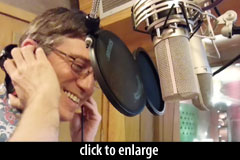
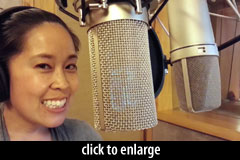



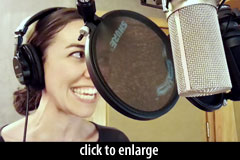


David Beneke
July 10th, 2013 at 5:01 pm
Perfect shootout! Million Dollar voices, studio and equipment, doesn’t get any better. The AT 5040 is certainly a worthy contender against any of these mics, the Neumann sounds tubby (is that a real term?), the Lawson to my ears was the real winner of all the samples on all voices. Are the files compressed here? If so it would be nice to download the uncompressed files and listen in a DAW.
Randy Coppinger
July 12th, 2013 at 6:15 am
Thank you for the kind words, David. Every one of these mikes has strengths and weaknesses. The reason I love to conduct comparisons like this is to learn better which mic to choose for each recording situation.
I would like to make the full bandwidth files available David. I’d also like to apply a typical processing chain on these recordings and hear how they fair after compression, EQ, etc. I plan to post that kind of follow-up work to my site in the weeks to come.
Steve Faul
July 13th, 2013 at 1:54 pm
Excellent shootout, and a real education in voice acting.
I’m going to buck the trend and say that to my ears listening on AKG240 headphones the U87Ai sounded cleaner than the AT5040. Especially with Corey, the midrange seemed to be a bit muddy on the AT5040, as if he was off axis. Maybe my ears are more “tuned” to a U87, but that’s the impression I got. Still, the AT5040 is up to the task.
The most fascinating comparison was against the Lawson. Corey’s characters fairly leaped into my ears on the Lawson, with a low end was profound yet natural. BUT the AT5040 added gravel to “character 2” that gave it more dimension. At that point, it comes down to a creative choice based on what you’re trying to achieve. Either mic is a winner, but personally I’d love to take home a Lawson.
It’s a shame Corey didn’t use the Gefell. I would’ve liked a direct comparison there. The UMT70S complimented Yuri’s natural delivery, while again I felt the AT5040 put a slight scoop in his midrange. The U87Ai added brightness to his more upbeat delivery, but not too much. For Yuri, the Gefell is the winner.
The AT5040 is a winner on female voices, although the difference between it and the U87Ai to me was very subtle. With the AT5040, you might never use the de-esser or high-pass filter ever again.
Randy Coppinger
July 17th, 2013 at 7:55 am
Thanks for giving the recordings such a thorough and thoughtful listen, Steve. I think each one of these mikes is great under the right circumstances. The 87 is popular for a reason. The L47 is one of my mainstay mikes for voice. When I first started using the Gefell I didn’t fall in love with it, but then I realized that I was often EQing other voice mikes to sound like the raw character of the UMT70 in the final mix. It’s especially helpful for tenor and alto range voices. Agreed, I wish it was practical to hear all of the mikes on all of the voices, but we spent the better part of an evening just recording what’s been presented here. Thanks again and happy recording.
David Beneke
July 19th, 2013 at 12:25 pm
Looking forward to the samples Randy. Looking at the studio photos and remembering my previous experiences with U87’s, what I may be hearing is slap back from the control room window. The U87 picks up the room more than most mics I have worked with, which is a testament to the mics sensitivity. Steve above is right, different headphones do make the mics sound different AKG240’s give the mics a different sound than Beyer DT 770 Pros, but listening with both makes me lust for a Lawson!
COZ
August 5th, 2013 at 5:47 pm
I have always loved the AT4050. The mic sounds great on its own or if you run it through a processor. For the price tag it is a buy and sounds as good as mics worth much more.
bern21
August 31st, 2013 at 10:01 am
The L47 sounds best. The 5040 (5400?) just sounds ‘tubby’ to me. Perhaps, buy 3 to 6 mics with character, rather than the 5040.
Perfectionist
May 11th, 2014 at 4:23 am
I have rare ears so you’re lucky to get my analysis:
The 5040 will not be a success. There is no possible chance because I am objectively correct – the 5040 will factually hurt people’s ears. A-T is going to have to work on some revision.
I hear lots of crackling, HF breaking, distorting, clicking, sharp resonant frequencies that sound like spit inside the mouth being amplified in a negative way.
Not pleasant to listen to and the problems were consistent across every take and actor. It’s a kind of inconsistent breaking resonant distortion.
Really nasty sounding. Not professional.
Slau
May 11th, 2014 at 2:25 pm
Hey Perfectionist,
I have a rare mind so you’re lucky to get my reply to your comment. Whether you realize it or not, you’re in the minority with your views on the 5040 by an outrageous margin. That should tell you something. That’s all.
super hearing
May 18th, 2015 at 1:35 am
Perfectionist… I think your ears/hearing is breaking up at your ears upper hf ceiling of 9khz. You are the only person I know that has said that… maybe you need to question your bionic hearing 🙁
Frank
March 20th, 2017 at 10:36 am
Great shootout. I really enjoyed both the Lawson and the AT5040. It’s clear though that character-wise they were in different places for me yet still very high quality.
For the most part (and I know there’s exceptions) but I feel men’s voices tend to be more powerful while women’s voices are more articulate.
I felt the Lawson was fantastic on the men’s voices. It had this smoothing effect that kind of reminded me of when you open a tub of peanut butter and smooth it over with a knife. It just had this great way of adding this thickness and glue to the male voice and making it this powerful, yet smooth sound.
The AT5040 has this laser clarity in the mids that’s amazing. The Lawson had more of a smoothness in the mids and highs, which was also amazing but sounded more like a soft filter for audio. I’m stopping short of saying “veiled” because that word seems to take on a negative connotation but if there’s a good veiled, that’s the Lawson. It’s like a fine mesh that adds a dreamy quality. I can totally hear what people mean when they say that the Lawson sound clip jumped out for having a certain something.
For the men’s voices, which were more powerful, the laser clarity of the AT5040 gave the men’s voices too much of an edge to me whereas that smoothing effect of the Lawson kept the power in check and gave it a cohesiveness.
Conversely the same softness in the Lawson that I felt excelled on the men, softened the women’s voices too much and blurred some of the detail in the high mids and highs. The laser clarity of the AT5040 really brings the articulation of a woman’s voice into amazing focus and gave it a dimensionality. In short, all the mics made the women sound like a great audio recording, but in particular the AT5040 made it sound like the woman was right in front of me, as if I could actually reach out and touch her. That kind of floored me and I attribute it to the AT5040s ability to really enhance the articulation.
Of course it also depends if that’s the effect you want on the voice.
None of the mics fell short and I wouldn’t mind working with any of them and if I had one, I’d have no problem as I’m really picking nits here because of the benefit of being able to hear a shootout. But in reality, if I had one, I’d be fine using it on any of the voices.
But to me, I’d tend to lean on going towards what most of what my clientele are. I do tend to work with a lot more women than men so I’m really interested in checking out the AT5040 more. In a perfect world, I’d love to have both the Lawson and the AT5040.
The beautiful thing is we’re not talking C800 prices for either, so the possibility of owning both at some point in the future isn’t really unrealistic. I can see myself owning the AT5040 and picking up the Lawson at a later date. Besides, the fact that they’re both extremely different in character, as well as technology (tube/solid state, transformer/transformerless, etc) makes it a worthwhile investment because they’re not overly similar in overall tone so they cover a wide range for a combined price that’s still less than a C800 or a U87.
Thanks for the effort – this was a fun shootout to listen to.